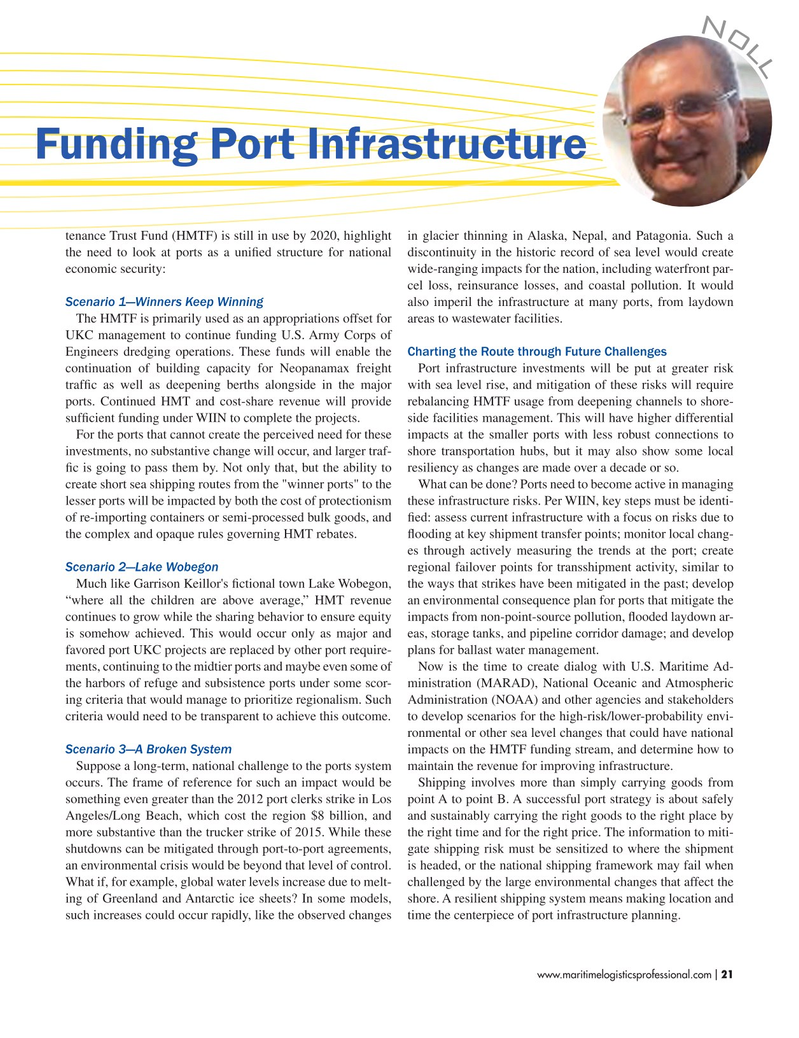
Page 21: of Maritime Logistics Professional Magazine (May/Jun 2017)
BUNKER OPERATIONS & PORTS
Read this page in Pdf, Flash or Html5 edition of May/Jun 2017 Maritime Logistics Professional Magazine
N o l l
Funding Port Infrastructure tenance Trust Fund (HMTF) is still in use by 2020, highlight in glacier thinning in Alaska, Nepal, and Patagonia. Such a the need to look at ports as a unifed structure for national discontinuity in the historic record of sea level would create economic security: wide-ranging impacts for the nation, including waterfront par- cel loss, reinsurance losses, and coastal pollution. It would
Scenario 1—Winners Keep Winning also imperil the infrastructure at many ports, from laydown
The HMTF is primarily used as an appropriations offset for areas to wastewater facilities.
UKC management to continue funding U.S. Army Corps of
Engineers dredging operations. These funds will enable the Charting the Route through Future Challenges continuation of building capacity for Neopanamax freight Port infrastructure investments will be put at greater risk traffc as well as deepening berths alongside in the major with sea level rise, and mitigation of these risks will require ports. Continued HMT and cost-share revenue will provide rebalancing HMTF usage from deepening channels to shore- suffcient funding under WIIN to complete the projects. side facilities management. This will have higher differential
For the ports that cannot create the perceived need for these impacts at the smaller ports with less robust connections to investments, no substantive change will occur, and larger traf- shore transportation hubs, but it may also show some local fc is going to pass them by. Not only that, but the ability to resiliency as changes are made over a decade or so.
create short sea shipping routes from the "winner ports" to the What can be done? Ports need to become active in managing lesser ports will be impacted by both the cost of protectionism these infrastructure risks. Per WIIN, key steps must be identi- of re-importing containers or semi-processed bulk goods, and fed: assess current infrastructure with a focus on risks due to the complex and opaque rules governing HMT rebates. fooding at key shipment transfer points; monitor local chang- es through actively measuring the trends at the port; create
Scenario 2—Lake Wobegon regional failover points for transshipment activity, similar to
Much like Garrison Keillor's fctional town Lake Wobegon, the ways that strikes have been mitigated in the past; develop “where all the children are above average,” HMT revenue an environmental consequence plan for ports that mitigate the continues to grow while the sharing behavior to ensure equity impacts from non-point-source pollution, fooded laydown ar- is somehow achieved. This would occur only as major and eas, storage tanks, and pipeline corridor damage; and develop favored port UKC projects are replaced by other port require- plans for ballast water management.
ments, continuing to the midtier ports and maybe even some of Now is the time to create dialog with U.S. Maritime Ad- the harbors of refuge and subsistence ports under some scor- ministration (MARAD), National Oceanic and Atmospheric ing criteria that would manage to prioritize regionalism. Such Administration (NOAA) and other agencies and stakeholders criteria would need to be transparent to achieve this outcome. to develop scenarios for the high-risk/lower-probability envi- ronmental or other sea level changes that could have national
Scenario 3—A Broken System impacts on the HMTF funding stream, and determine how to
Suppose a long-term, national challenge to the ports system maintain the revenue for improving infrastructure. occurs. The frame of reference for such an impact would be Shipping involves more than simply carrying goods from something even greater than the 2012 port clerks strike in Los point A to point B. A successful port strategy is about safely
Angeles/Long Beach, which cost the region $8 billion, and and sustainably carrying the right goods to the right place by more substantive than the trucker strike of 2015. While these the right time and for the right price. The information to miti- shutdowns can be mitigated through port-to-port agreements, gate shipping risk must be sensitized to where the shipment an environmental crisis would be beyond that level of control. is headed, or the national shipping framework may fail when
What if, for example, global water levels increase due to melt- challenged by the large environmental changes that affect the ing of Greenland and Antarctic ice sheets? In some models, shore. A resilient shipping system means making location and such increases could occur rapidly, like the observed changes time the centerpiece of port infrastructure planning.
www.maritimelogisticsprofessional.com 21
I

 20
20

 22
22
